There’s no doubt that 2020 was a wild year for real estate. From the Covid-19 pause that stopped showings and sales entirely, to the slow recovery and crashing rental market in condo-saturated Manhattan, to hot markets in metro-area suburbs, there were plenty of downs and ups.
From the Manhattan condo and rental recovery to what will happen with inventory, we gathered some predictions on what the market holds for 2021.
When Condos Will Recover
Eric Benaim, chief executive officer and founder of Queens, N.Y.-based brokerage Modern Spaces, says he expects to start seeing the condo market pick up by the second quarter of 2021.
“Many developers reduced pricing during COVID, so buyers will now see an opportunity to purchase a ‘value,’” Benaim says. “The FED has said it plans on holding the current interest rates until 2023, which will also help.”
Rental Recovery?
Andrew Barrocas, the chief executive officer of New York City brokerage MNS, thinks the New York City market will recover 50% of what was lost by the summer of 2021, though all experts say it depends on how many employees return to the office and how many businesses recruit new employees to work onsite.
“That’s contingent on 50% of people returning to the office,” Barrocas says. “If 75% return, the market will recover 75%. If it’s 25%, the market will recover 25%. We have 20,000 vacant apartments right now. It’s purely a supply and demand issue. There’s a direct correlation with the rental market and people retuning to the office and with the current trends, I feel 50% of people will be back in Summer 2021. It’s what makes New York, New York.”
Jared Antin, director of sales at New York City’s Elegran brokerage firm, thinks it will take at least 18 to 24 months for things to turn around.
“Although the amount of new leases being signed this fall are comparable to the amount signed this time last year, the non-renewal rate is through the roof, causing an incredible increase in inventory and pressure for landlords,” Antin says. “The vacancy rate in NYC has risen above 5% for the first time in at least 14 years, and landlords are dropping prices and increasing concessions to fill the vacancies. It will take 18 to 24 months, and at least two cycles of new employees coming to NYC, to absorb this inventory. During this time, we will see minimal new rental inventory in the pipeline. When the inventory does absorb, we will then see prices increase until new inventory can be built.”
Benaim of Modern Spaces agrees that the rental market in New York City has a long way to go to recovery.
“Available inventory is at a record high and new units that are hitting the market now will take some time to be absorbed,” Benaim says. “My hope is that as more and more people start to come back to work available inventory will be absorbed, and I believe if all goes well, then the rental market should be back to near pre-Coronavirus numbers by September when schools will open and there is more consumer certainty and confidence.”
Scott Meyer, chief investment officer at real estate investment and development firm PTM Partners, thinks the rental market may be buoyed by people who underestimated the challenges of homeownership.
“We have a couple at Watermark (in Washington, DC) who sold their single-family home to rent a two-bedroom after realizing they did not want to deal with the hassle of home maintenance and renovations,” Meyer says.
Even More Flexibility
Flexibility in lease terms is here to stay, and Will Lucas, founder and chief executive officer of Mint House, which provides high-end, short term rentals for business travelers, predicted that 5 to 10% of multifamily buildings in urban areas will sign agreements with a short-term rental or corporate housing company to combat a tough lease-up environment.
“Lease terms will become more flexible as individuals travel and temporarily relocate given the work-from-home trends driven by the coronavirus pandemic,” Lucas says. “We have already seen an increase in guests signing on to stay with us anywhere from two months to nine months to avoid signing a full-year lease.”
Increased Inventory
Michael Nourmand, president of Los Angeles-based brokerage firm Nourmand & Associates, believes inventory should increase.
“Right now, inventory is very low because of economic and political uncertainty as well as health concerns,” Nourmand says. “In addition, you have rising prices so sellers are benefitting from holding off on selling their properties. …Price appreciation will level off. I think demand will remain strong because Los Angeles is a desirable place to live but supply will increase so price appreciation will slow down. In addition, low interest rates are already baked into the equation.”
Second-Home Syndrome
After busy markets in vacation communities, Mark Durliat, chief executive officer and co-founder of Grace Bay Resorts, predicts even more vacation home purchases.
“People are vacationing differently now than ever before, and many are putting a bigger focus on privacy and cleanliness while still having the benefits of exclusivity and luxury,” Durliat says. “Vacation homes provide the confidence that travelers will always return to a clean and safe space. What’s more, vacation homes in a managed community … offer real potential for rental income that can offset ownership expenses.”
Along with the rise of the vacation home, Hunter Frick, senior vice president of marketing at Brown Harris Stevens Development Marketing, predicts the rise of the “co-primary residence,” or an apartment near the office in the city.
“As executives who decamped to areas outside Manhattan ease into month nine of work from home, their mindset has changed indefinitely,” Frick says. “They will never abandon the unrivaled energy of Manhattan, but it’s a place where they will spend three days a week before they retreat to their homes upstate, in the Hamptons and Connecticut. Many will look to find new housing closer to the office, which will help the struggling Midtown residential market.”
“This lifestyle aligns with feedback we are receiving from our current buyer pool,” Frick continued. “Most anticipate the future of work as a much more fluid and flexible where work and life blend.”
Though it’s yet to be seen what the controversial resurfacing of the pied-à-terre tax will do to that market.
Increased Foreign Interest
While foreign investment has been slow this year, and some say it never left, some in the industry believe it’s coming back along with the continued opening of new developments.
“Condo demand won’t die long term,” Jim Cohen, president of residential for Florida-based FontaineBleau Development. “I’m in continuous communication with the 1% international buyer pool. People still want waterfront living in Miami and not just single-family homes. Waterfront investments mean a ton of maintenance and serious insurance policies. So while the pandemic has shown the importance of space and privacy through the increase of sales in the single-family home market —Miami-Dade sales jumped 16.6% year-over-year according to the Miami Association of Realtors — a mansion in the sky with a resort-style lifestyle sans the hassle of maintenance may be the better option. Our newest waterfront luxury project, Turnberry Ocean Club offers family-size duplex condos and 70,000 square feet of indoor/outdoor amenities that include a coffee lounge, two restaurants and a three-floor sky club. During the pandemic, we actually sold a number of units to international buyers, which make up 30% of our buyer pool. My takeaway, people still want the resort-style luxury experience.”
Dan Kodsi, chief executive officer of Florida-based Royal Palm Companies, thinks renewed foreign investment provides a market for smaller units.
“The foreign buyer is looking for resort-like homes that are practical and functional with a sense of sophistication and luxury that they can return to once or twice a year that can be maintained for them,” Kodsi says. “The new fully furnished microLUXE residences at Legacy Hotel and Residences offer micro floor plans with no rental restrictions. About 75% of Legacy Hotel and Residences’ buyers are international.”
Virtual And VIP
Greg Willett, chief Economist at RealPage, a real estate technology and analytics firm, says the use of virtual leasing and communication tools will continue to expand, with functions moved offsite.
“Similarly, we will see more virtual leasing — not just virtual tours — and there will be expanded virtual resident engagement, including resident-to-resident interaction,” Willett says.
Elana Friedman, chief marketing officer for AKA, which offers long-stay hotel residences, says amenity spaces will be reservation-only for Covid-19 safety.
“At AKA, residents have the ability to book our shared common areas and amenities, like our cinema,” Friedman says.
Source: Forbes





